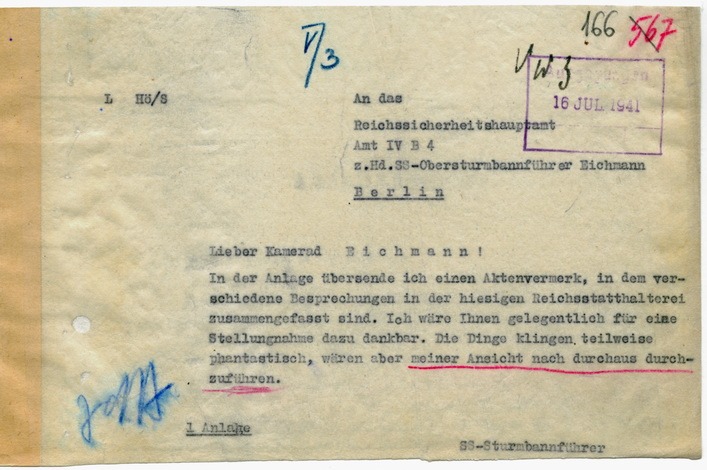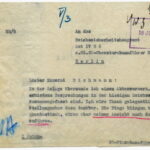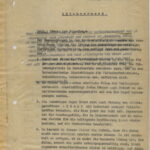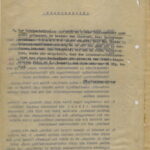Höppner and Eichmann
On July 16, 1941, officials in the Reichsgau Wartheland met to discuss what they referred to – using the usual euphemisms – as the “solution of the Jewish question.” Rolf-Heinz Höppner, who headed the SD and the Umwandererzentralstelle (Migration Office) in Posen, later sent a summary of the meeting’s proposals to Adolf Eichmann, asking for his opinion. Höppner described some of the ideas as “fantastic, yet entirely viable. Among the suggestions were plans for mass sterilization and the creation of a large camp to hold the region’s Jewish population, but also whether it might not be “the most humane solution” to kill all Jews unable to work, using “some quick-acting agent” – a measure justified by the anticipated food shortages that winter. This document exposes the genocidal inclinations within the Warthegau’s corridors of power. It foreshadows the killing operations soon to be carried out by Sonderkommando Lange against the Jewish population of the area.
Document

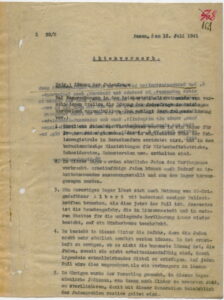
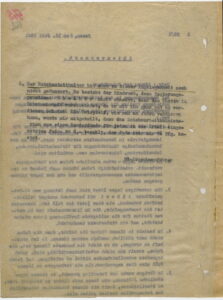
L Hö/S
An das Reichssicherheitshauptamt
Amt IV B 4
z.Hd. SS-Obersturmbannführer Eichmann
Berlin
Lieber Kamerad Eichmann!
In der Anlage übersende ich einen Aktenvermerk, in dem verschiedene Besprechungen in der hiesigen Reichsstatthalterei zusammengefaßt sind. Ich wäre Ihnen gelegentlich für eine Stellungnahme dazu dankbar. Die Dinge klingen teilweise phantastisch, wären aber meiner Ansicht nach durchaus durchzuführen.
SS-Sturmbannführer
1 Anlage
L Hö/S Posen, den 16. Juli 1941
Aktenvermerk
Betr.: Lösung der Judenfrage
Bei Besprechungen in der Reichsstatthalterei wurde von verschiedenen Stellen die Lösung der Judenfrage im Reichsgau Wartheland angeschnitten. Man schlägt dort folgende Lösung vor:
1. Sämtliche Juden des Warthegaues werden in ein Lager für 300 000 Juden genommen, das in möglichster Nähe der Kohlenmagistrale in Barackenform errichtet wird, und in dem barackenmäßige Einrichtungen für Wirtschaftsbetriebe, Schneidereien, Schustereien usw. enthalten sind.
2. In dieses Lager werden sämtliche Juden des Warthegaues verbracht. Arbeitsfähige Juden können nach Bedarf zu Arbeitskommandos zusammengestellt und aus dem Lager herausgezogen werden.
3. Ein derartiges Lager läßt sich nach Meinung von SS-Brigadeführer Albert mit bedeutend weniger Polizeikräften bewachen, als dies jetzt der Fall ist. Außerdem ist die Seuchengefahr, die in Litzmannstadt und in anderen Ghettos für die umliegende Bevölkerung immer wieder besteht, auf ein Mindestmaß beschränkt.
4. Es besteht in diesem Winter die Gefahr, daß die Juden nicht mehr sämtlich ernährt werden können. Es ist ernsthaft zu erwägen, ob es nicht die humanste Lösung ist, die Juden, soweit sie nicht arbeitseinsatzfähig sind, durch irgendein schnellwirkendes Mittel zu erledigen. Auf jeden Fall wäre dies angenehmer, als sie verhungern zu lassen.
5. Im übrigen wurde der Vorschlag gemacht, in diesem Lager sämtliche Jüdinnen, von denen noch Kinder zu erwarten sind, zu sterilisieren, damit mit dieser Generation tatsächlich das Judenproblem restlos gelöst wird.
6. Der Reichsstatthalter hat sich zu dieser Angelegenheit noch nicht geäußert. Es besteht der Eindruck, daß Regierungspräsident Übelhör nicht wünscht, daß das Ghetto in Litzmannstadt verschwindet, da er mit ihm ganz gut zu verdienen scheint. Als Beispiel, wie man an Juden verdienen kann, wurde mir mitgeteilt, daß das Reichsarbeitsministerium aus einem Sonderfonds für jeden in der Arbeit eingesetzten Juden RM 6 bezahlt, der Jude aber nur 80 Pfg. kostet.
SS-Sturmbannführer
L Hö/S
To the Reichssicherheitshauptamt
Office IV B 4
to the attention of SS-Obersturmbannführer Eichmann
Berlin
Dear Comrade Eichmann,
Attached please find a memorandum summarizing various meetings at the local Reichsstatthalterei. I would appreciate your occasional feedback on it. Some of the things sound fantastic, but in my opinion, they are entirely feasible.
SS-Sturmbannführer
1 Enclosement
L Hö/S Posen, 16 July 1941
Memo
Re.: Solution of the Jewish Question
During meetings at the Reichsstatthalterei, the issue of the Jewish question in the Reichsgau Wartheland was brought up by various parties. The following solution is proposed there:
1. All Jews of the Warthegau will be taken to a camp for 300,000 Jews, which will be constructed in the closest proximity possible to the coal transport route in the form of barracks, and will include barracks-style facilities for economic activities, tailoring, shoemaking, etc.
2. All Jews of the Warthegau will be brought to this camp. Able-bodied Jews can be assembled into work units as needed and pulled out of the camp.
3. According to SS-Brigadeführer Albert, such a camp can be guarded with significantly fewer police forces than is currently the case. Additionally, the risk of epidemics, which repeatedly threatens the surrounding population in Litzmannstadt and other ghettos, is minimized.
4. There is a danger this winter that the Jews may not all be able to be fed. It is seriously worth considering whether the most humane solution is not to eliminate the Jews, as far as they are not capable of working, by some quick-acting agent. In any case, this would be more pleasant than letting them starve.
5. Furthermore, the proposal was made to sterilize all Jewish women in this camp who are still expecting children, so that with this generation, the Jewish problem is indeed completely solved.
6. The Reichsstatthalter has not yet commented on this matter. There is the impression that Government President Übelhör does not want the ghetto in Litzmannstadt to disappear, as he seems to be making quite a profit from it. As an example of how one can profit from Jews, I was informed that the Reich Ministry of Labor pays RM 6 from a special fund for every Jew employed in work, but the Jew costs only 80 Pfg.
SS-Sturmbannführer
Archivial reference:
IPN, GK 196/36, p. 166-167.
Quoted in:
Die Verfolgung und Ermordung der europäischen Juden durch das nationalsozialistische Deutschland 1933–1945 Band 4 Polen September 1939 – Juli 1941, München: Oldenbourg Wissenschaftsverlag, 2011, p. 680 – 681.
Images shared by Patrick Montague at forum.axishistory.com on 15 November, 2013. See also at phdn.org.
